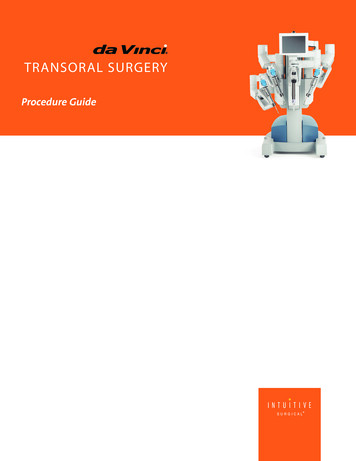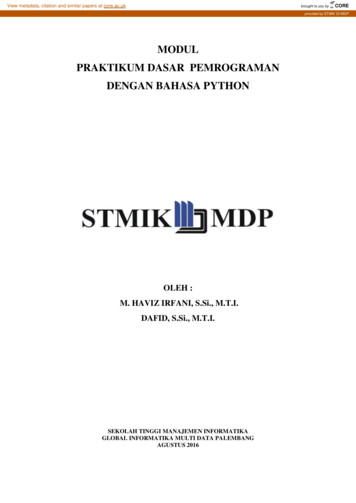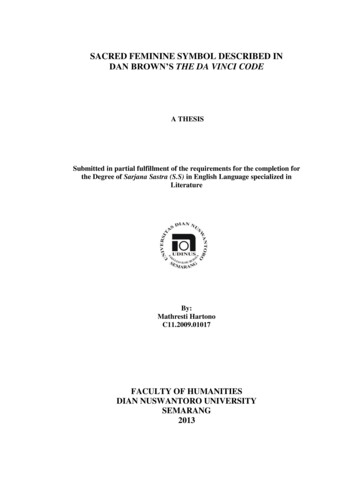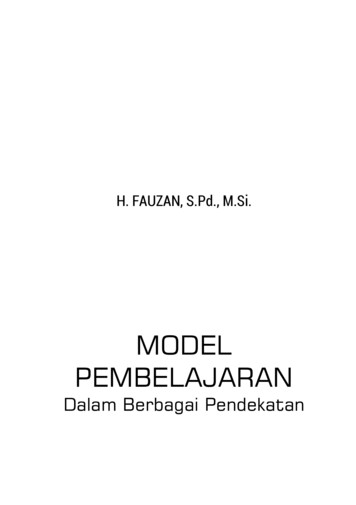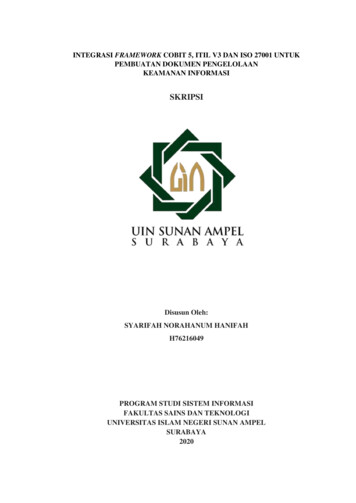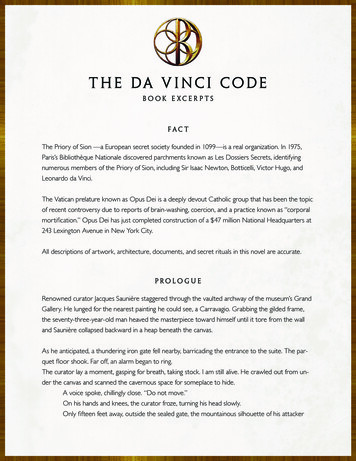
Transcription
T h e Da V i n c i C o d eBook E xcer p t sFac tThe Priory of Sion —a European secret society founded in 1099—is a real organization. In 1975,Paris’s Bibliothèque Nationale discovered parchments known as Les Dossiers Secrets, identifyingnumerous members of the Priory of Sion, including Sir Isaac Newton, Botticelli, Victor Hugo, andLeonardo da Vinci.The Vatican prelature known as Opus Dei is a deeply devout Catholic group that has been the topicof recent controversy due to reports of brain-washing, coercion, and a practice known as “corporalmortification.” Opus Dei has just completed construction of a 47 million National Headquarters at243 Lexington Avenue in New York City.All descriptions of artwork, architecture, documents, and secret rituals in this novel are accurate.PROLOGUERenowned curator Jacques Saunière staggered through the vaulted archway of the museum’s GrandGallery. He lunged for the nearest painting he could see, a Carravagio. Grabbing the gilded frame,the seventy-three-year-old man heaved the masterpiece toward himself until it tore from the walland Saunière collapsed backward in a heap beneath the canvas.As he anticipated, a thundering iron gate fell nearby, barricading the entrance to the suite. The parquet floor shook. Far off, an alarm began to ring.The curator lay a moment, gasping for breath, taking stock. I am still alive. He crawled out from under the canvas and scanned the cavernous space for someplace to hide.A voice spoke, chillingly close. “Do not move.”On his hands and knees, the curator froze, turning his head slowly.Only fifteen feet away, outside the sealed gate, the mountainous silhouette of his attacker
stared through the iron bars. He was broad and tall, with ghost-pale skin and thinning white hair.His irises were pink with dark red pupils. The albino drew a pistol from his coat and aimed the longsilencer through the bars, directly at the curator. “You should not have run.” His accent was not easyto place. “Now tell me where it is.”“I told you already,” the curator stammered, kneeling defenseless on the floor of the gallery.“I have no idea what you are talking about!”“You are lying.” The man stared at him, perfectly immobile except for the glint in his ghostlyeyes. “You and your brethren possess something that is not yours.”The curator felt a surge of adrenalin. How could he possibly know this?“Tonight therightful guardians will be restored. Tell me where it is hidden, and you will live.” The man leveled hisgun at the curator’s head. “Is it a secret you will die for?”Saunière could not breathe.The man tilted his head and closed one eye, peering down the barrel of his gun.Saunière held up his hands in defense. “Wait,” he said slowly. “I will tell you what you need toknow.” The curator spoke his next words carefully. The lie he told was one he had rehearsed manytimes.each time praying he would never have to use it.When the curator had finished speaking, his assailant smiled smugly. “Yes. This is exactly what theothers told me.”Saunière recoiled. The others?“I found them, too,” the huge man taunted. “All three of them. They confirmed what youhave just said.”It cannot be! The curator’s true identity, along with the identities of his three sénéchaux, wasalmost as sacred as the ancient secret they protected.Saunière now realized his sénéchaux, following strict procedure, had told the same lie before theirown deaths. It was part of the protocol.The attacker aimed his gun again. “When you are gone, I will be the only one who knowsthe truth.”The truth. In an instant, the curator grasped the true horror of the situation. If I die, the truthwill be lost forever. Instinctively, he tried to scramble for cover.The silencer spat, and the curator felt a searing heat as the bullet lodged in his stomach. He fell forward.struggling against the pain. Slowly, Saunière rolled over and stared back through the bars at hisattacker.The man was now taking dead aim at Saunière’s head.Saunière closed his eyes, his thoughts a swirling tempest of fear and regret. The click of anempty chamber echoed through the corridor.The curator’s eyes flew open.
The man glanced down at his weapon, looking almost amused. He reached for a second clip,but then seemed to reconsider, smirking calmly at Saunière’s gut. “My work here is done.”The curator looked down and saw the bullet hole in his white linen shirt. It was framed by asmall circle of blood a few inches below his breastbone. My stomach. Almost cruelly, the bullet hadmissed his heart. As a veteran of La Guerre d’Algérie, the curator had witnessed this horribly drawnout death before. For fifteen minutes, he would survive as his stomach acids seeped into his chestcavity, slowly poisoning him from within.“Pain is good, monsieur,” the man said.Then he was gone.Alone now, Jacques Saunière turned his gaze again to the iron gate. He was trapped, and thedoors could not be reopened for at least twenty minutes. By the time anyone got to him, he wouldbe dead. Even so, the fear that now gripped him was a fear far greater than that of his own death.I must pass on the secret.Staggering to his feet, he pictured his three murdered brethren. He thought of the generations who had come before them.of the mission with which they had all been entrusted.An unbroken chain of knowledge.Suddenly, now, despite all the precaution.despite all the fail safes.Jacques Saunière was the onlyremaining link, the sole guardian of one of the most powerful secrets ever kept.Shivering, he pulled himself to his feet.I must find some way.He was trapped inside the Grand Gallery, and there existed only one person on earth to whom hecould pass the torch. Saunière gazed up at the walls of his opulent prison. A collection of the world’smost famous paintings seemed to smile down on him like old friends.Wincing in pain, he summoned all of his faculties and strength. The desperate task before him, heknew, would require every remaining second of his life.Chapter 1Robert Langdon awoke slowly.A telephone was ringing in the darkness-a tinny, unfamiliar ring. He fumbled for the bedsidelamp and turned it on. Squinting at his surroundings he saw a plush Renaissance bedroom with LouisXVI furniture, hand-frescoed walls, and a colossal mahogany four-poster bed.Where the hell am I?The jacquard bathrobe hanging on his bedpost bore the monogram: HOTEL RITZ PARIS.Slowly, the fog began to lift.
Langdon picked up the receiver. “Hello?”“Monsieur Langdon?” a man’s voice said. “I hope I have not awoken you?”Dazed, Langdonlooked at the bedside clock. It was 12:32 A.M. He had been asleep only an hour, but he felt like thedead.“This is the concierge, monsieur. I apologize for this intrusion, but you have a visitor. He insists it isurgent.”Langdon still felt fuzzy. A visitor? His eyes focused now on a crumpled flyer on his bedside table.THE AMERICAN UNIVERSITY OF PARISproudly presentsan evening with Robert LangdonProfessor of Religious Symbology, Harvard UniversityLangdon groaned. Tonight’s lecture-a slide show about pagan symbolism hidden in the stones ofChartres Cathedral-had probably ruffled some conservative feathers in the audience. Most likely,some religious scholar had trailed him home to pick a fight.“I’m sorry,” Langdon said, “but I’m very tired and-”“Mais monsieur,” the concierge pressed, lowering his voice to an urgent whisper. “Your guest is animportant man.”Langdon had little doubt. His books on religious paintings and cult symbology had made him a reluctant celebrity in the art world, and last year Langdon’s visibility had increased a hundred-fold after hisinvolvement in a widely publicized incident at the Vatican. Since then, the stream of self-importanthistorians and art buffs arriving at his door had seemed never-ending.“If you would be so kind,” Langdon said, doing his best to remain polite, “could you take the man’sname and number, and tell him I’ll try to call him before I leave Paris on Tuesday? Thank you.” Hehung up before the concierge could protest. Sitting up now, Langdon frowned at his bedside GuestRelations Handbook, whose cover boasted: SLEEP LIKE A BABY IN THE CITY OF LIGHTS. SLUMBER AT THE PARIS RITZ. He turned and gazed tiredly into the full-length mirror across the room.The man staring back at him was a stranger-tousled and weary.You need a vacation, Robert.The past year had taken a heavy toll on him, but he didn’t appreciate seeing proof in the mirror. Hisusually sharp blue eyes looked hazy and drawn tonight. A dark stubble was shrouding his strong jawand dimpled chin. Around his temples, the gray highlights were advancing, making their way deeperinto his thicket of coarse black hair. Although his female colleagues insisted the gray only accentuatedhis bookish appeal, Langdon knew better.If Boston Magazine could see me now.Last month, much to Langdon’s embarrassment, Boston Magazine had listed him as one of that city’s
top ten most intriguing people-a dubious honor that made him the brunt of endless ribbing by hisHarvard colleagues. Tonight, three thousand miles from home, the accolade had resurfaced to haunthim at the lecture he had given.“Ladies and gentlemen.” the hostess had announced to a full house at The American University ofParis’s Pavillon Dauphine, “Our guest tonight needs no introduction. He is the author of numerousbooks: The Symbology of Secret Sects, The Art of the Illuminati, The Lost Language of Ideograms,and when I say he wrote the book on Religious Iconology, I mean that quite literally. Many of you usehis textbooks in class.”The students in the crowd nodded enthusiastically.“I had planned to introduce him tonight by sharing his impressive curriculum vitae. However.” Sheglanced playfully at Langdon, who was seated onstage. “An audience member has just handed me afar more, shall we say.intriguing introduction.”She held up a copy of Boston Magazine.v Langdon cringed. Where the hell did she get that?The hostess began reading choice excerpts from the inane article, and Langdon felt himself sinkinglower and lower in his chair. Thirty seconds later, the crowd was grinning, and the woman showedno signs of letting up. “And Mr. Langdon’s refusal to speak publicly about his unusual role in last year’sVatican conclave certainly wins him points on our intrigue-o-meter.” The hostess goaded the crowd.“Would you like to hear more?”The crowd applauded.Somebody stop her, Langdon pleaded as she dove into the article again.“Although ProfessorLangdon might not be considered hunk-handsome like some of our younger awardees, this forty-sixyear-old academic has more than his share of scholarly allure. His captivating presence is punctuatedby an unusually low, baritone speaking voice, which his female students describe as ‘chocolate for theears.’’’The hall erupted in laughter.Langdon forced an awkward smile. He knew what came next-some ridiculous line about “HarrisonFord in Harris tweed”-and because this evening he had figured it was finally safe again to wear hisHarris tweed and Burberry turtleneck, he decided to take action.“Thank you, Monique,” Langdon said, standing prematurely and edging her away from the podium.“Boston Magazine clearly has a gift for fiction.” He turned to the audience with an embarrassed sigh.“And if I find which one of you provided that article, I’ll have the consulate deport you.”The crowd laughed.“Well, folks, as you all know, I’m here tonight to talk about the power of symbols.”The ringing of Langdon’s hotel phone once again broke the silence.up. “Yes?”Groaning in disbelief, he picked
As expected, it was the concierge. “Mr. Langdon, again my apologies. I am calling to inform you thatyour guest is now en route to your room. I thought I should alert you.”Langdon was wide awake now.“You sent someone to my room?”“I apologize, monsieur, but a man like this.I cannot presume the authority to stop him.”“Who exactly is he?”But the concierge was gone.Almost immediately, a heavy fist pounded on Langdon’s door.Uncertain, Langdon slid off the bed, feeling his toes sink deep into the savonniere carpet. He donnedthe hotel bathrobe and moved toward the door. “Who is it?”“Mr. Langdon? I need to speak with you.” The man’s English was accented-a sharp, authoritative bark.“My name is Lieutenant Jérome Collet. Direction Centrale Police Judiciaire.”Langdon paused. The Judicial Police? The DCPJ were the rough equivalent of the U.S. FBI.Leaving the security chain in place, Langdon opened the door a few inches. The face staring back athim was thin and washed out. The man was exceptionally lean, dressed in an official-looking blueuniform.“May I come in?” the agent asked.Langdon hesitated, feeling uncertain as the stranger’s sallow eyes studied him. “What is this is allabout?”“My capitaine requires your expertise in a private matter.”“Now?” Langdon managed. “It’s after midnight.”“Am I correct that you were scheduled to meet with the curator of the Louvre this evening? “Langdon felt a sudden surge of uneasiness. He and the revered curator Jacques Saunière had beenslated to meet for drinks after Langdon’s lecture tonight, but Saunière had never shown up. “Yes.How did you know that?”“We found your name in his daily planner.”“I trust nothing is wrong?”The agent gave a dire sigh and slid a Polaroid snapshot through the narrow opening in the door.When Langdon saw the photo, his entire body went rigid.“This photo was taken less than an hour ago. Inside the Louvre.”As Langdon stared at the bizarre image, his initial revulsion and shock gave way to a sudden upwelling of anger. “Who would do this!”“We had hoped that you might help us answer that very question, considering your knowledge insymbology and your plans to meet with him.” Langdon stared at the picture, his horror now laced
with fear. The image was gruesome and profoundly strange, bringing with it an unsettling sense ofdéjà vu. A little over a year ago, Langdon had received a photograph of a corpse and a similar request for help. Twenty-four hours later, he had almost lost his life inside Vatican City. This photo wasentirely different, and yet something about the scenario felt disquietingly familiar.The agent checked his watch. “My capitaine is waiting, sir.” Langdon barely heard him. His eyes werestill riveted on the picture. “This symbol here, and the way his body is so oddly.”“Positioned?” the agent offered.Langdon nodded, feeling a chill as he looked up. “I can’t imagine who would do this to someone.”The agent looked grim. “You don’t understand, Mr. Langdon. What you see in this photograph.” Hepaused. “Monsieur Saunière did that to himself.”Chapter 2One mile away, the hulking albino named Silas limped through the front gate of the luxurious brownstone residence on Rue la Bruyère. The spiked cilice belt that he wore around his thigh cut into hisflesh, and yet his soul sang with satisfaction of service to the Lord.Pain is good.His red eyes scanned the lobby as he entered the residence. Empty. He climbed the stairs quietly,not wanting to awaken any of his fellow numeraries. His bedroom door was open; locks were forbidden here. He entered, closing the door behind him.The room was spartan-hardwood floors, a pine dresser, a canvas mat in the corner that served ashis bed. He was a visitor here this week, and yet for many years he had been blessed with a similarsanctuary in New York City.The Lord has provided me shelter and purpose in my life.Tonight, at last, Silas felt he had begun to repay his debt. Hurrying to the dresser, he found the cellphone hidden in his bottom drawer and placed a call to a private extension.“Yes?” a male voice answered.“Teacher, I have returned.”“Speak,” the voice commanded, sounding pleased to hear from him.“All four are gone. The three sénéchaux.and the grandmaster himself.”There was a momentary pause, as if for prayer. “Then I assume you have the information?”“All four concurred. Independently.”“And you believed them?”“Their agreement was too great for coincidence.”An excited breath. “Superb. I had feared the brotherhood’s reputation for secrecy might prevail.”
“The prospect of death is strong motivation.”“So, my pupil, tell me what I must know.”Silas knew the information he had gleaned from his victims would come as a shock. “Teacher, all fourconfirmed the existence of the clef de voûte.the legendary keystone.”He heard a quick intake of breath over the phone and could feel the Teacher’s excitement. “Thekeystone. Exactly as we suspected.”According to lore, the brotherhood had created a map of stone-a clef de voûte.or keystone—anengraved tablet that revealed the final resting place of the brotherhood’s greatest secret.informationso powerful that its protection was the reason for the brotherhood’s very existence.“When we possess the keystone,” the Teacher said, “we will be only one step away.”“We are closer than you think. The keystone is here in Paris.”“Paris? Incredible. It is almost too easy.”Silas relayed the earlier events of the evening.how all four of his victims, moments before death, haddesperately tried to buy back their Godless lives by telling their secret. Each had told Silas the exactsame thing-that the keystone was ingeniously hidden at a precise location inside one of Paris’s ancientchurches—Eglise de Saint-Sulpice.“Inside a House of the Lord,” the Teacher exclaimed. “How they mock us!” “As they have for centuries.”The Teacher fell silent, as if letting the triumph of this moment settle over him. Finally, hespoke. “You have done a great service to God. We have waited centuries for this. You must retrievethe stone for me. Immediately. Tonight. You understand the stakes.”Silas knew the stakes were incalculable, and yet what the Teacher was now commanding seemedimpossible. “But the church, it is a fortress. Especially at night. How will I enter?” With the confidenttone of man of enormous influence, the Teacher explained what was to be done.When Silas hung up the phone, his skin tingled with anticipation.One hour, he told himself, grateful that the Teacher had given him time to carry out the necessarypenance before entering a house of God. I must purge my soul of today’s sins. The sins committedtoday had been Holy in purpose. Acts of war against the enemies of God had been committed forcenturies. Forgiveness was assured.Even so, Silas knew, absolution required sacrifice.Pulling his shades, he stripped naked and knelt in the center of his room. Looking down, he examined the spiked cilice belt clamped around his thigh. All true followers of The Way wore this device-aleather strap, studded with sharp metal barbs that cut into the flesh as a perpetual reminder ofChrist’s suffering. The pain caused by the device also helped counteract the desires of the flesh.
Although Silas already had worn his cilice today longer than the requisite two hours, he knew todaywas no ordinary day. Grasping the buckle, he cinched it one notch tighter, wincing as the barbs dugdeeper into his flesh. Exhaling slowly, he savored the cleansing ritual of his pain.Pain is good, Silas whispered, repeating the sacred mantra of Father Josemaria Escriva-the Teacherof all Teachers. Although Escriva had died in 1975, his wisdom lived on, his words still whispered bythousands of faithful servants around the globe as they knelt on the floor and performed the sacredpractice known as “corporal mortification.”Silas turned his attention now to a heavy knotted rope coiled neatly on the floor beside him. TheDiscipline. The knots were caked with dried blood. Eager for the purifying effects of his own agony,Silas said a quick prayer. Then, gripping one end of the rope, he closed his eyes and swung it hardover his shoulder, feeling the knots slap against his back. He whipped it over his shoulder again, slashing at his flesh. Again and again, he lashed.Castigo corpus meum.Finally, he felt the blood begin to flow.chapter 3The crisp April air whipped through the open window of the Citroën ZX as it skimmed south pastthe Opera House and crossed Place Vendôme. In the passenger seat, Robert Langdon felt the citytear past him as he tried to clear his thoughts. His quick shower and shave had left him lookingreasonably presentable but had done little to ease his anxiety. The frightening image of the curator’sbody remained locked in his mind.Jacques Saunière is dead.Langdon could not help but feel a deep sense of loss at the curator’s death. Despite Saunière’sreputation for being reclusive, his recognition for dedication to the arts made him an easy man torevere. His books on the secret codes hidden in the paintings of Poussin and Teniers were some ofLangdon’s favorite classroom texts. Tonight’s meeting had been one Langdon was very much lookingforward to, and he was disappointed when the curator had not shown.Again the image of the curator’s body flashed in his mind. Jacques Saunière did that to himself? Langdon turned and looked out the window, forcing the picture from his mind.Outside, the city was just now winding down-street vendors wheeling carts of candied amandes,waiters carrying bags of garbage to the curb, a pair of late night lovers cuddling to stay warm in abreeze scented with juniper blossom. The Citroën navigated the chaos with authority, its dissonanttwo-tone siren parting the traffic like a knife.“Le capitaine was pleased to discover you were still in Paris tonight,” the agent said, speaking for thefirst time since they’d left the hotel. “A fortunate coincidence.”
Langdon was feeling anything but fortunate, and coincidence was a concept he did not entirely trust.As someone who had spent his life exploring the hidden interconnectivity of disparate emblems andideologies, Langdon viewed the world as a web of profoundly intertwined histories and events. Theconnections may be invisible, he often preached to his symbology classes at Harvard, but they arealways there, buried just beneath the surface.“I assume,” Langdon said, “that American University in Paris told you where I was staying?”The driver shook his head. “Interpol.”Interpol, Langdon thought. Of course. He had forgotten that the seemingly innocuousrequest of all European hotels to see a passport at check-in was more than a quaint formality-itwas the law. On any given night, all across Europe, Interpol officials could pinpoint exactly who wassleeping where. Finding Langdon at the Ritz had probably taken all of five seconds.As the Citroën accelerated southward across the city, the illuminated profile of the Eiffel Tower appeared, shooting skyward in the distance to the right. Seeing it, Langdon thought of Vittoria, recallingtheir playful promise a year ago that every six months they would meet again at a different romanticspot on the globe. The Eiffel Tower, Langdon suspected, would have made their list. Sadly, he lastkissed Vittoria in a noisy airport in Rome more than a year ago.“Did you mount her?” the agent asked, looking over.Langdon glanced up, certain he had misunderstood. “I beg your pardon?”“She is lovely, no?” The agent motioned through the windshield toward the Eiffel Tower.“Have you mounted her?”Langdon rolled his eyes. “No, I haven’t climbed the tower.”“She is the symbol of France. I think she is perfect.” Langdon nodded absently. Symbologists oftenremarked that France-a country renowned for machismo, womanizing, and diminutive insecureleaders like Napoleon and Pepin the Short-could not have chosen a more apt national emblem thana thousand-foot phallus.When they reached the intersection at Rue de Rivoli, the traffic light was red, but the Citroën didn’tslow. The agent gunned the sedan across the junction and sped onto a wooded section of Rue Castiglione, which served as the northern entrance to the famed Tuileries Gardens-Paris’s own versionof Central Park. Most tourists mistranslated Jardins des Tuileries as relating to the thousands of tulipsthat bloomed here, but Tuileries was actually a literal reference to something far less romantic. Thispark had once been an enormous, polluted excavation pit from which Parisian contractors minedclay to manufacture the city’s famous red roofing tiles-or tuiles.As they entered the deserted park, the agent reached under the dash and turned off the blaringsiren. Langdon exhaled, savoring the sudden quiet. Outside the car, the pale wash of halogen headlights skimmed over the crushed gravel parkway, the rugged whirr of the tires intoning a hypnotic
rhythm. Langdon had always considered the Tuileries to be sacred ground. These were the gardensin which Claude Monet had experimented with form and color, and literally inspired the birth of theImpressionist movement. Tonight, however, this place held a strange aura of foreboding.The Citroën swerved left now, angling west down the park’s central boulevard. Curling around acircular pond, the driver cut across a desolate avenue out into a wide quadrangle beyond. Langdoncould now see the end of the Tuileries Gardens, marked by a giant stone archway.Arc du Carrousel.Despite the orgiastic rituals once held at the Arc du Carrousel, art aficionados revered this place foranother reason entirely. From the esplanade at the end of the Tuileries, four of the finest art museums in the world could be seen.one at each point of the compass.Out the right-hand window, south across the Seine and Quai Voltaire, Langdon could see thedramatically lit façade of the old train station—now the esteemed Musée d’Orsay. Glancing left, hecould make out the top of the ultra-modern Pompidou Center, which housed the Museum of Modern Art. Behind him to the west, Langdon knew the ancient obelisk of Ramses rose above the trees,marking the Musée Jeu de Paume.But it was straight ahead, to the east, through the archway, that Langdon could now see the monolithic Renaissance palace that had become the most famous art museum in the world.Musée du Louvre.Langdon felt a familiar tinge of wonder as his eyes made a futile attempt to absorb the entiremass of the edifice. Across a staggeringly expansive plaza, the imposing facade of the Louvre roselike a citadel against the Paris sky. Shaped like an enormous horseshoe, the Louvre was the longestbuilding in Europe, stretching farther than three Eiffel Towers laid end to end. Not even the millionsquare feet of open plaza between the museum wings could challenge the majesty of the façade’sbreadth. Langdon had once walked the Louvre’s entire perimeter, an astonishing three-mile journey.Despite the estimated five days it would take a visitor to properly appreciate the 65,300 pieces ofart in this building, most tourists chose an abbreviated experience Langdon referred to as “LouvreLite”-a full sprint through the museum to see the three most famous objects: The Mona Lisa, Venusde Milo, and Winged Victory. Art Buchwald had once boasted he’d seen all three masterpieces infive minutes and fifty-six seconds.The driver pulled out a handheld walkie-talkie and spoke in rapid-fire French. “MonsieurLangdon est arrivé. Deux minutes.”An indecipherable confirmation came crackling back.The agent stowed the device, turning now to Langdon. “You will meet the capitaine at the mainentrance.”The driver ignored the signs prohibiting auto traffic on the plaza, revved the engine, and gunned the
Citroën up over the curb. The Louvre’s main entrance was visible now, rising boldly in the distance,encircled by seven triangular infinity pools from which spouted illuminated fountains.La Pyramide.The new entrance to the Paris Louvre had become almost as famous as the museum itself. Thecontroversial, neo-modern glass pyramid designed by Chinese-born American architect I. M. Peistill evoked scorn from traditionalists who felt it destroyed the dignity of the Renaissance courtyard.Goethe had described architecture as frozen music, and Pei’s critics described this pyramid as fingernails on a chalkboard. Progressive admirers, though, hailed Pei’s seventy-one-foot tall, transparentpyramid as a dazzling synergy of ancient structure and modern method-a symbolic link between theold and new—helping usher the Louvre into the next millennium.“Do you like our pyramid?” the agent asked.Langdon frowned. The French, it seemed, loved to ask Americans this. It was a loaded question, ofcourse. Admitting you liked the pyramid made you a tasteless American, and expressing dislike wasan insult to the French.“Mitterrand was a bold man,” Langdon replied, splitting the difference. The late French presidentwho had commissioned the pyramid was said to have suffered from a “Pharaoh-complex.” Single-handedly responsible for filling Paris with Egyptian obelisks, art, and artifacts, Francois Mitterrandhad an affinity for Egyptian culture that was so all-consuming that the French still referred to him asThe Sphinx. “What is the captain’s name?” Langdon asked, changing topics.“Bezu Fache,” the driver said, approaching the pyramid’s main entrance. “We call him Le Taureau.”Langdon glanced over at him, wondering if every Frenchman had a mysterious animal epithet. “You call your captain The Bull?”The man arched his eyebrows. “Your French is better than you admit, Monsieur Langdon.”My French stinks, Langdon thought, but my zodiac iconography is pretty good. Taurus was always thebull. Astrology was a symbolic constant all over the world.The agent pulled the car to a stop and pointed between two fountains to a large door in the side ofthe pyramid. “There is the entrance. Good luck, monsieur.” “You’re not coming?”“My orders are to leave you here. I have other business to attend to.” Langdon heaved a sigh andclimbed out. It’s your circus.The agent revved his engine and sped off.As Langdon stood alone and watched the departing tail lights, he realized he could easily reconsider,exit the courtyard, grab a taxi, and head home to bed. Something told him it was probably a lousyidea.As he moved toward the mist of the fountains, Langdon had the uneasy sense he was crossing animaginary threshold into another world. The drea
The Da Vinci Code Book Excerpts Fact The Priory of Sion —a European secret society founded in 1099—is a real organization. In 1975, Paris’s Bibliothèque Nationale discovered parchments known as Les Dossiers Secrets, identifying numerous members of the Priory of Sion, including Sir Isaac Newton, Botticelli, Victor Hugo, and Leonardo da Vinci.File Size: 1MB


